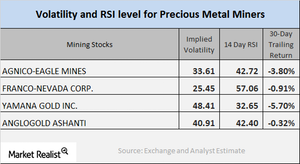Mining Shares: RSI Numbers and Implied Volatility
As of October 19, Sibanye Gold, Agnico Eagle Mines, Silver Wheaton, and Randgold Resources had implied volatility readings of 63%, 33.6%, 30.8%, and 25%.
Oct. 23 2017, Published 12:23 p.m. ET

Technical analysis
When investors consider parking money in mining shares, there are a few key indicators that they need to watch. In this part, we’ll discuss the RSI (relative strength index) levels and call implied volatility. Mining stocks’ volatility can often be higher than the metals.
Call implied volatility is used to measure the fluctuations in an asset’s price, given the variations in the price of its call option. The RSI indicates whether a share is overpriced or underpriced—above 70 suggests that it’s overbought and below 30 suggests that it’s oversold.
Notably, the iShares Gold Trust (IAU) and the iShares Silver Trust (SLV) rose 0.65% and 1.3%, respectively, on October 19, 2017.
Call implied volatility and RSI level
As of October 19, 2017, Sibanye Gold (SBGL), Agnico Eagle Mines (AEM), Silver Wheaton (SLW), and Randgold Resources (GOLD) had implied volatility readings of 63%, 33.6%, 30.8%, and 25%, respectively.
The above mining shares’ RSI levels have recovered recently. Sibanye Gold, Agnico Eagle Mines, Silver Wheaton, and Randgold Resources have RSI scores of 76.5, 41.7, 82.2, and 51.3, respectively. These RSI numbers indicate that the mining stocks’ prices have rebounded after the fall in September.
An RSI level above 70 indicates that the share price might fall, while an RSI below 30 indicates that the price might rise.
Mining shares’ 30-day trailing returns are mixed.
